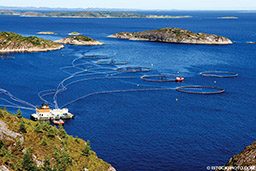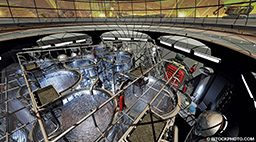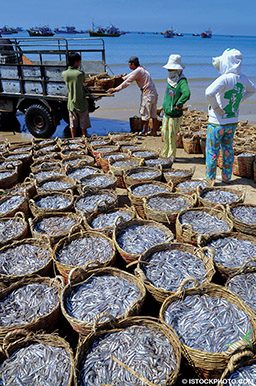Having spent time below the surface of the ocean, divers are more likely than most other people to care about the various impacts of our seafood choices. But that doesn’t necessarily make it any easier to decipher what it means to eat seafood sustainably.
For one, the seafood industry isn’t static. A great deal has changed in recent years, leaving many consumers with questions such as these: Is wild seafood always a better choice than farmed? What’s the carbon footprint of my choices? And where should we turn to find the latest science-based information?
While wild seafood is still popular with many consumers, Ryan Bigelow, outreach manager for the Monterey Bay Aquarium Seafood Watch program, sees the commercial fishing industry as too successful for its own good.
“It’s one thing to go out and catch a fish with a pole and line; it’s entirely another thing to go out with satellite tracking, sophisticated radar and nets that are large enough to catch a small plane,” he said. “We’re so good at it now that fish don’t really stand a chance.

“It makes a lot more sense to move away from that — at least to some extent,” he continued, “and focus on farming, which can be done in controlled situations.”
Farmed seafood, however, has gotten a bad rap among ecologically minded consumers — and for good reason. Escapes, disease and pollution were often commonplace in the early days of the industry.
“The American public still has a bad image of aquaculture,” Bigelow said. “But a lot of that is based on historical tropes — some that were not very accurate and some that were accurate in many cases but not across the board.”
Seafood Watch, which is known for compiling the latest science on farmed and wild fish and informing the public with its trusted consumer guides,1 has begun to include more farmed fish in its green “best choices” and yellow “good alternatives” listings. Bigelow says that trend is likely to continue — mainly out of necessity.
“If we were to have all of our wild fisheries managed at ‘best choice’ level, we still wouldn’t have enough fish to feed us all,” Bigelow said. “There is no future without aquaculture. So when you look at it through that lens, it behooves us to find the most sustainable way to farm our fish.”
Fish farms now provide more than half of the seafood eaten globally, and that number is rising quickly to accommodate a growing population. It makes sense then that, like most relatively new industries, aquaculture has had to do a lot of growing up recently — and fast.
Changes in the Agriculture Industry
For years, the biggest challenge associated with aquaculture was the fact that farmed fish often required sizable quantities of wild seafood to grow to market weight. Known as the feed-conversion ratio or “fish-in/fish-out” ratio, the quantity of wild fish required to feed popular carnivorous species such as salmon, tuna and shrimp was generally much higher than the quantity of fish harvested. In the case of salmon, it often took as much as three pounds of wild fish to produce one pound of salmon.

Now the bulk of the industry is working to replace a portion of that feed with high-protein plant materials (soy meal, brewers grains, etc.), farmed insects and fish oil. There is also a shift toward farming herbivorous species such as tilapia, mussels and clams.
Bigelow also mentioned the trend of aquaculture companies to move toward contained, on-land systems and systems located in areas where escaped fish can’t compete with their wild counterparts. Indoor fish farms that use recirculating systems — wherein the water is filtered and reused — are especially likely to be sustainable. “You can drop almost any species in a recirculating aquaculture system (RAS), and it’s going to get a Seafood Watch green recommendation,” he said.
When companies build fish farms in the ocean, Bigelow said, “many have stopped saying, ‘there’s wild salmon here, so let’s just build a farm here.'” For this reason and others, the likelihood that the fish will carry disease or wreak biological havoc if and when they escape into the wild is decreasing.
Taylor Voorhees, Seafood Watch senior aquaculture scientist, agrees. He said he has seen fish farmers make much more careful decisions about where to build their farms in recent years.
“We’ve realized that deeper water with more tidal flushing is typically better,” Voorhees said. “And sites that have hard bottoms are typically better than those that have softer, muddy bottoms. All of those things are more likely to be able to disperse the waste that comes out of the pens and therefore have less of an impact.”
The Argument for Wild
Not everyone sees aquaculture as the future of seafood. Geoff Shester, the California program director at Oceana, a global nonprofit aimed at protecting and restoring the world’s oceans, would rather see more consumers opt for wild seafood that’s low on the food chain.
Shester echoes the sentiments of Oceana’s chief executive officer, Andy Sharpless, whose book The Perfect Protein proposes a radical shift in the way American consumers view seafood. Both Sharpless and Shester invite seafood eaters to take an especially close look at what’s happening to forage fish — species such as mackerel, sardines and anchovies — which are being caught at massive rates and fed to farmed fish and land-based livestock in the form of fishmeal and fish oil.
“Globally more than 90 percent of the forage fish that are removed from the ocean are fed to other animals. It’s an inefficient use of what we’re already removing,” Shester said. The solution? We should eat many more of the foraged fish ourselves. If we did so, Oceana calculates that there would be about 400 million more seafood meals available worldwide every year.
“The rest of the sustainable seafood world has gone down this path of, ‘It’s OK if you feed them, as long as you feed them less fish,'” Shester said, “but the problem is whenever you feed an animal, you have to take into account the full life cycle and the effect upstream — the water and energy use and all that.”
As Shester sees it, the ocean is much more than a source of food. “It provides air, it provides the weather, it provides for amazing wildlife…,” he said. “So the question we need to ask ourselves is: Do we want a future where the ocean is feedlots or a food web?”
He believes the solution is seafood that doesn’t need to be fed: forage fish, farmed bivalves (oysters, mussels, clams, etc.) and more responsibly caught wild seafood.
When it comes to greenhouse gas emissions — a piece of the environmental puzzle with a direct impact on the ocean via acidification2 — some studies show that wild fish have one of the lowest carbon footprints of any protein available.
“North American seine-caught sardines have half the carbon footprint of organic lentils and about a quarter of the footprint of tofu or peanut butter,” Shester said.
Consumer Disconnect and Fraud
On a macro level both Shester and Seafood Watch’s Bigelow pointed to Americans’ lack of connection to the source of their food and the resulting gap in basic understanding. “Divers, surfers and costal residents are some of our biggest supporters,” Bigelow said, “but most other Americans have no real contact with the ocean, so it’s difficult for them to imagine what a fish farm is, let alone what sets apart the sustainable ones.”
Shester agreed. “We have a pretty strong disconnect between what we eat and where it’s coming from,” he said. “So the more you can become familiar with what species you’re eating, what method was used to farm or catch it, and who the fishers were, the better.”
Oceana is one of a number of groups that have tested seafood in restaurants and grocery stores to identify how often the species being sold is the one actually appearing on consumers’ plates. The group released a report in September 2016 that found that of the of the 25,000 seafood samples it analyzed, 20 percent — one in five — were incorrectly labeled.3
“You can walk into a store or restaurant and get something other than what you’re buying … but the store owner or chef may have been lied to. It’s a symptom of the larger lack of traceability,” Bigelow said. And more important, fraud makes other consumer decision-making moot.
“We’re very interested in figuring out the traceability issue,” Voorhees said, “because the lack of it has the real potential to undermine the work that we do here [at Seafood Watch] in putting together these recommendations.”
Traceability in Wild Seafood
When it comes to traceability in wild seafood, the Marine Stewardship Council (MSC) oversees the largest global effort to connect consumers with fish that has been managed and caught responsibly.4
“When you buy MSC-certified wild fish,” said John Corsiglia, the organization’s U.S. media manager, “you’re supporting fisherfolks who have gone through an extensive evaluation to prove that the way they’re fishing isn’t depleting fish stocks, and there’s good government management of the fishery.” The group uses a single, easy-to-recognize blue label, and it does not rate fisheries against one another like Seafood Watch does. But the organization makes a map available on its website where a user can locate and read about, for example, the West Greenland cold-water prawn fishery or the North Pacific albacore tuna fishery, among dozens of others around the world.

“If you want to keep it simple, just look for the MSC label,” Corsiglia said. “Or if you want to look under the hood, there are public assessment reports for every fishery. All the stakeholder comments are available publicly.”
“MSC has a staff of about 150 people working around the globe to analyze government data and assess fisheries,” he continued. “The group’s sustainable fisheries standard was developed in the late-1990s with input from industry, governments, nongovernmental organizations (NGOs) and the science and academic communities. The standard is also periodically reviewed (with multiple stakeholders) as new science emerges, and the latest update occurred two years ago.”
About 10 percent of the total global catch is MSC certified. While in some regions it’s much higher (in the U.S. Pacific Northwest, for instance, 83 percent of the fisheries are certified), the developing world can pose a challenge for the MSC — especially nations in which the government doesn’t collect data on fisheries.
In these cases, the MSC tries to help. “We do a lot of work with fisheries to help them find funding — both charitable and government — to help them gather data,” Corsiglia said.
Changes Afoot Internationally
More than 85 percent of the fish and shellfish Americans eat is imported, and a great deal of it comes from Asia. A cascade of news reports about slavery and other human rights violations in the fishing industry,5 as well as growing concern about farming practices and antibiotics use in China, Thailand and other parts of Asia, have raised concern among some consumers interested in fair and sustainable food.
While there has historically been a lack of transparency about Asian seafood in the U.S., Seafood Watch’s Bigelow and Voorhees can attest to some significant changes on the horizon. While Bigelow says the vast majority of Asian imports still fall into the red “avoid” category in their seafood guides, a number of Asian companies are expressing interest in reaching consumers who care about how their fish is caught and raised.
“Those companies are coming to us for advice about how to get out of the red and how to get into the green,” he said. “In the beginning it was just [Seafood Watch] talking to consumers, and now that has shifted completely to where we are sitting down with these governments to talk about how they can create sustainable products.”
Voorhees has made several trips to Asia to consult on best aquaculture practices, and he and other Seafood Watch staff are working with a group called the Asian Seafood Improvement Collaborative to broker a stronger connection to Asian producers.6 In the Thai shrimp industry, for example, which was particularly hard-hit by disease recently, Voorhees says he has seen “almost the entire industry switching to a more closed-pond system” in an act of self-preservation that will also cut down significantly on pollution.
“We’re excited about where it’s going,” Bigelow added. “We hope a lot of those industries are turning the tide.”
References
1. Consumer guides. Monterey Bay Aquarium Seafood Watch. seafoodwatch.org/seafood-recommendations/consumer-guides
2. Ocean acidification: the other carbon dioxide problem. National Oceanic and Atmospheric Administration. pmel.noaa.gov/co2/story/Ocean+Acidification
3. 1 in 5 seafood samples mislabeled worldwide, finds new Oceana report. oceana.org/press-center/press-releases/1-5-seafood-samples-mislabeled-worldwide-finds-new-oceana-report
4. What we do. Marine Stewardship Council. msc.org/about-us/what-we-do
5. An AP investigation helps free slaves in the 21st century. Associated Press. March 24, 2015,–Sept. 8, 2016. ap.org/explore/seafood-from-slaves
6. Building consensus and strategies for sustainability in the Asian seafood industry. Asian Seafood Improvement Collaborative. asicollaborative.org/why-we-do-what-we-do/
Explore More
© Alert Diver — Q4 Fall 2016